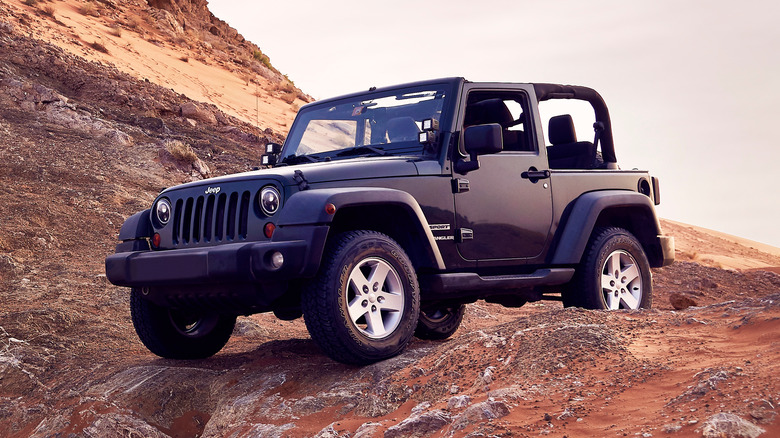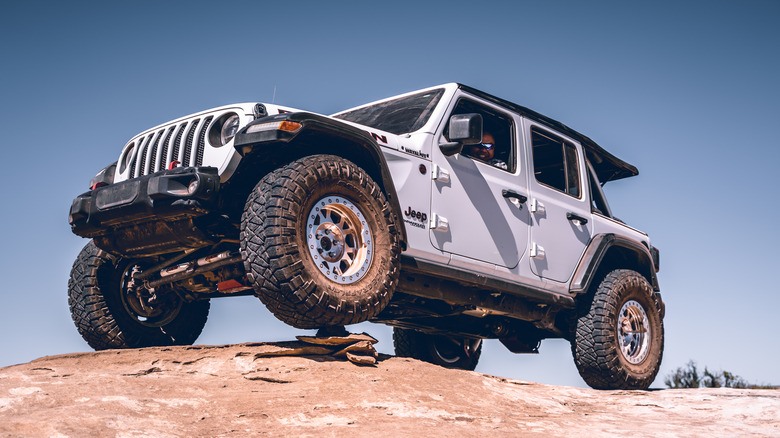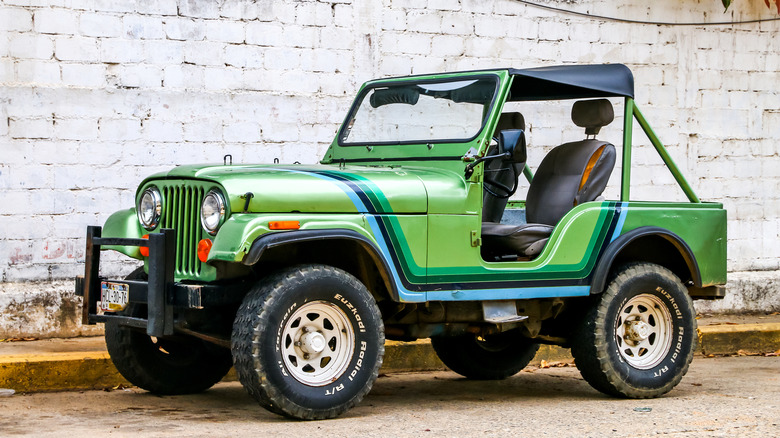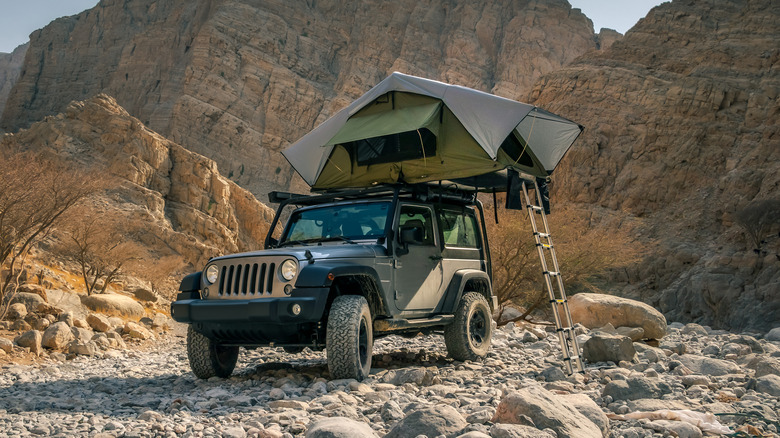What Really Makes Jeeps Incredible Climbers
For over eight decades, Jeep has had an established reputation as a brand for outdoorsmen and competition off-roaders. Despite releasing some comfier and more economy-minded models in recent years, that reputation is not for nothing. Countless overlanders still flock for capable off-road vehicles. The modern Wrangler series in particular still carries a lot of that rugged DNA and a lot of the heavy-duty equipment that makes Jeeps so capable off-road.
Some Jeep owners build their vehicles into extreme off-road machines known as rock crawlers. You can usually identify one by its giant tires, lifted suspension, cut-away body panels, and thick roll cage. Crawlers will also usually be packing custom transmissions that are geared less for speed, and more for torque delivery. This allows them to move very slowly over inclines that no other vehicle could clear. At a rock crawling competition, you might see some Broncos, and some Toyotas, but Jeep will be by far the most represented brand. Let's examine what makes these Jeeps so capable.
Part-Time Four Wheel Drive
Nowadays, four-wheel drive and all-wheel drive systems are fairly common in trucks, crossovers, and even some sports cars. When the Jeep was introduced, this was not the case. The very first model was commissioned by the U.S. army in 1940. They wanted a lightweight truck that could navigate rough terrain quickly and was four-wheel drive capable. The original designation was "General Purpose Vehicle," or GP. At some point, the acronym gave way to the nickname Jeep.
These first Jeep models came in the nick of time, as the United States entered World War II in 1941. Many of these vehicles were shipped out to the German and Japanese campaigns and proved very capable in less-than-ideal conditions. Upon the war's end in 1945, a civilian model was introduced, known as the CJ series. For many, the CJ was the general population's first exposure to four-wheel drive. This made the truck a hit with farmers and nature enthusiasts.
The CJ and its modern successor, the Wrangler, come with a manual 4x4 system. While driving on the street, the Jeep is rear-wheel drive. This allows it to corner sharply and take tight curves. Once off the road. The driver is able to engage four-wheel drive using a dedicated lever. This locks the transfer case and forces the front and rear wheels to rotate in unison, helping to eliminate wheelspin on loose surfaces and steep inclines.
Solid Axles
When it comes to transferring engine power to the ground, the simplest mechanism is known as the solid or 'live' axle. It consists of a sturdy steel tube, with a spinning shaft on the inside that sends energy from the differential out to the driving wheel. These axles are paired with an equally simple suspension design, using leaf or coil springs.
Nowadays, most solid axles have been replaced with independent suspension systems, which have continuously variable joints and thin exposed driveshafts for added flexibility. However, the CJ and Wrangler have stuck with the old solid axle design, which many off-roaders still swear by.
While an independent suspension is more capable on the street, it has some disadvantages. The CV joints that allow the system to bend are also vulnerable weak points while off-roading. A rock can bash into the axles and warp them, or damage the joints directly. A bad enough impact could even detach the driveshaft from its wheel, stranding the vehicle.
You'll have no such issues with the old-fashioned live axle. Since the driveshaft is protected by a thick layer of steel, it can take plenty of hits from rocks and keep on going. The simplicity of the design also makes it less prone to wear over time and makes suspension lifts easier to install.
Locking Differentials
In addition to four-wheel drive, many Jeeps come equipped with locking differentials to eliminate wheelspin and put the power down. A differential's purpose is to take energy from the main driveshaft and send it to the left and right sides of the vehicle. The typical car design, known as an open diff, allows each drive wheel to rotate at a different speed. This is necessary for sharp turning and helps prevent drivetrain wear.
However, this design has a fatal flaw off-road. An open diff will only send 100% of its power to one wheel or the other, which is terrible for low traction scenarios. If a regular car is caught slipping on mud or ice, one wheel will spin uselessly, while the other won't move at all. Locking diffs solve this problem by having linkages that temporarily bolt the two sides of the axle together.
In situations where wheelspin occurs, a Jeep owner can engage the differential lock and put 100% of their power to the ground at all times. This means they can maintain traction in places that would be impossible for other vehicles, especially when combined with the 4x4 system. Locking differentials are currently standard on Wrangler Rubicon models.
Reliable, Powerful Engines
Through much of Jeep's life in the 20th century, it was a subsidiary of the American Motors Corporation. During this time the Jeep brand became synonymous with AMC's venerable inline-six engine. This powerplant was available for every CJ model after 1972. In the mid-80s, AMC had to declare bankruptcy and was promptly bought up by Chrysler.
Despite new management, Jeep kept installing the 4.0-liter version of the straight six into many models, including the newly-christened Wrangler and the four-door XJ Cherokee. Chrysler kept on using the engine for another 20 years, retiring it with the last TJ Wranglers in 2006. The engine's long service life means that many can still be found on the road today, and maintenance parts are extremely common.
The simplicity of its design also allowed for great reliability, and they can easily last hundreds of thousands of miles. The 4.0 is also capable of making over 200 foot pounds of torque in a relatively compact size, which is a great combo for things like rock crawling. If you're not satisfied with stock power, engine upgrades can be found including exhaust, more aggressive camshafts, and supercharging kits.
Large Tires
One simple feature that makes Jeep CJs and Wranglers off-road capable is their ability to mount large tires. Many of them can pack rubber that's over 30 inches in diameter, and the current Rubicon can mount 35-inch tires without the need for a lift kit. Taller tires increase the driver's distance to the ground, and also push the driveline components further up. This means you can scale larger rocks without having to worry so much about banging into valuable components. Wrangler tires are also particularly wide, with 285-millimeter-wide shoes coming standard on the Rubicon.
More width means more surface area that comes in contact with the ground and therefore more traction. They also have deep treads to increase the effective surface area further on soft surfaces like mud. The most hardcore dirt tires have tread that continues up the sidewall. This is because they're designed to run at a lower air pressure off-road. With less air, the sidewall flexes and allows an even larger contact patch on the ground. Those who want even larger tires will opt for a lift kit, and in extreme cases remove fender panels for maximum clearance.
Compact Size
The original Willys was desired by the military for its light weight and small proportions, which also made the vehicle popular with enthusiast drivers. By the 1980's the Jeep CJ had a length under thirteen feet, with a width of five feet. This means the vehicle can easily squeeze into canyon passes and between trees. Generally, it can go places that full-size trucks cannot. The short length also reduces the risk of scraping the back bumper while climbing a steep incline. A wheelbase of 93 inches also allowed the CJ to navigate sharper corners.
In 2023, the two-door version of the Wrangler has grown an extra foot long and foot wide. It's larger, but still plenty compact compared to other mid-size SUVs and full-size trucks on the road today. It also manages to pack modern innovations like air conditioning, satellite navigation, airbags, and rollover protection into that tight space.
Aftermarket Support
For the enthusiast, Jeep may be the most aftermarket-supported brand in the United States. Countless accessories are available including heavy duty bumpers, powered winches, and lightbars. Additional mount points can be added to store things like tools, jerry cans, and full size spare tires.
If you want to get really serious about off-roading, you can also install suspension upgrades like a lift kit and high compression shock absorbers, paired with knobby over-sized tires. If your Jeep doesn't have a locking differential installed, plenty compatible options are available on the aftermarket. You can also opt for a shorter final drive ratio to increase effective torque.
Most dedicated rock crawler builds will possess a two-speed transfer case, meaning the Jeep has two available gear ratios with four wheel drive engaged. Four-high is geared normally, and is good for relatively high-speed engagements like driving over loose sand and gravel.
Four-low (AKA the crawler gear) uses a bunch of mechanical magic to reduce the output speed of the engine several times, but increasing effective torque output. On the most extreme crawlers, the driver can have the engine running at full speed, with the wheels only turning a couple miles per hour. This is horribly inefficient for road use, but is also the best possible mechanism for maintaining traction in extreme conditions.
Electronic Traction Control
There are plenty of Jeep purists out there that will only love the classic CJ, with the inline six, two doors, and a manual transmission. They scoff at anything modern, but modern technology comes with some undeniable benefits. When it comes to off-roading, electronic traction control has made drivers' lives a lot easier.
In 2023, computerized traction assistance can be found in most vehicles on the road, including every Jeep model. Chrysler implemented a brake-based traction control system into the Wrangler with the 2007 redesign. In these modern vehicles, the engine control and body control computer modules are constantly communicating with each other and relaying information on how the vehicle is handled.
In each wheel hub of the Jeep is a sensor that detects speed, and can accurately predict loss of traction. The vehicle's computer analyzes where the engine is sending power, and which wheels are losing traction. When it senses wheelspin, it applies braking force only to the side that is spinning. This means that the majority of torque gets sent out to the side with traction, and the vehicle can continue forward. If all wheels are spinning, the computer might also reduce the engine's power output to reign it into a more manageable state.
Modern Jeeps can also have separate driving modes for things like asphalt, gravel, sand, or snow. These computerized assists help make off-roading more accessible to enthusiasts at varying skill levels, and more people get to have fun on the trail.








